The logic of thinking. Part 16. Batch presentation of information
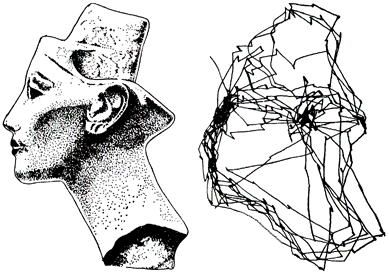
This series of articles describes a wave model of the brain that is seriously different from traditional models. I strongly recommend that those who have just joined start reading from the first part .
The information that the brain operates on, on the one hand, should fully describe what is happening, on the other hand, should be stored so as to allow the brain to perform the operations it requires. In principle, the format for describing information and the algorithms for processing it are closely related things. The first largely determines the second. Therefore, speaking of how the data stored by the brain can be organized, we, whether we like it or not, largely predetermine the system of subsequent thought processes. Since we will discuss the principles of thinking later, now we will focus only on how to ensure the completeness of the current description and subsequent storage of information. At the same time, implying that if, having reached the point of thinking, it turns out that the data format we have chosen fits the required algorithms, then
To understand what kind of description format the brain uses, let us trace the sequence of visual perception. Looking at the image, we “scan” it with quick eye movements, called saccades (drawing on KDPV). Each of them puts in the center of view one of the fragments of the overall picture. Descriptions appear on the zones of the visual cortex, corresponding to what we see at that moment in the center, what the periphery sees and what is the displacement as a result of the just done saccade. Each subsequent saccade creates a new picture. These descriptions replace each other one after another.
So, looking at the face, we first, for example, clearly see and recognize one eye, the one that the gaze is directed to. The remaining elements of the face that fall on the relative periphery of vision - the nose, mouth, and so on, we learn with less, but the same high probability. After each saccade, the central fragment changes, but the general set of recognized elements remains unchanged.
In principle, each of these separate descriptions that arise between saccades is enough to say that we have a face and even find out who it belongs to. But each individual description reliably speaks only of that object, which for him is located in the direction of the gaze. The remaining objects are determined fairly approximately.
If we want to get a more complete and detailed picture of the face, then the combination of all the descriptions that arise during the scan is suitable for this. In this case, it will be important not only to describe what kind of objects are recognized, but also information about the accompanying eye shifts. And here we come to a very important point. What is the final description that the visual analyzer should produce? Just a picture of the activity of a number of concepts? This corresponds only to that part of the description that we are seeing right now. But what about the rest? It turns out that a correct description that does not lose information is a package of simpler descriptions following one after another. Where each of the layers of such a temporary package describes only a certain part of the information, and a complete description is obtained as their combination. This is true provided
If we take a snapshot of the activity of the cerebral cortex, then the description of what is happening can be compared with a listing of active concepts in each of its zones. But such a description has a significant drawback. Suppose we want to describe the still life depicted in the figure below.

We can do this, for example, like this:
- A vase is slightly to the right of the center;
- Bouquet in a vase;
- Towel to the right of the vase;
- White flower on a towel;
- A bowl of raspberries on the left;
- Raspberries on a sheet to the left of the bowl;
- Three raspberries in front of a bowl;
- Raspberries to the right of the vase.
The general description consists of a set of such short descriptions. Each short description can, with some reservations, be replaced by a listing of the concepts included in it. But if we want to collect the final description by simply adding up all the concepts involved in the short transfers, then we will fail. With the addition, some of the information will disappear, as it will become unclear what belongs to what. But, in addition, it turns out that it is necessary to use some concepts several times. For example, it is raspberries both on the left and on the right, and in front of a bowl. And if we want to use this “simply assembled” description as an analogy to how such a still life is described in the zones of the cortex, it turns out that we have the same generalization of “raspberries” and it cannot be “active three times” at the same time. The way out of this situation, which seems logical to me, is to use a batch description. Each simple description can consist of a banal enumeration of active concepts. The full description is obtained as a set of simple descriptions. Since simple descriptions are separated in time, on the one hand it’s clear what it refers to, and, on the other hand, the same concept can occur several times in different layers of a package in different contexts.
Such a package presentation is very well correlated with reasoning about the amount of attention of a person. Psychologists, studying the properties of attention, have established that there is a limit to the number of objects on which a person can simultaneously concentrate. Usually this limit does not exceed seven objects. The first to measure the volume of attention using a mechanical tachistoscope was made by the founder of experimental psychology Wilhelm Wundt.

Tachitoscope - a device with which you can present consistent visual stimuli
Assessing the amount of attention is very simple. Look at the previous still life and try to calculate how many separate elements you are capable of, no, not to remember, this is different, but to keep it in your head at the same time. Or take a seven-digit phone number, for example, 1145618 and try to "hold" it in your head. Most likely, so that it does not disappear, you will have to loop in repeating it to yourself. If there are more than seven digits in the number, there is a great chance that it will not be possible to keep them all in memory. The maximum number of objects of still life or numbers that are perceived simultaneously gives an estimate of the amount of your attention.
Our assumption about the batch representation of information in the cerebral cortex allows us to compare each of the objects held in attention with one of the layers of the information packet.
If we imagine a cortex consisting of a small number of concepts, capable of formulating very simple thoughts regarding two objects “A” and “B”, then the package corresponding to the thought: “the red object A lies on the blue object B” will look as shown in the figure below.
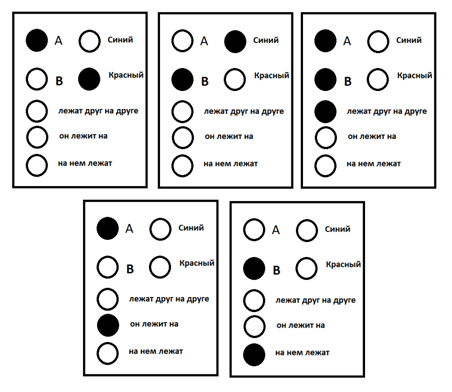
Information Package Example
Encoding complex descriptions
Let us return to memory and try to systematize with what types of information, and, accordingly, types of descriptions, our brain can operate.
The first type is a simple description that corresponds to a picture of the instantaneous activity of the cortex. This is a combination of those concepts that are detected by the brain right now.
The second type is a package of simple descriptions corresponding to one event, one thought. In the package, the order of the descriptions is not significant. Rearrangement of the layers of the package does not change the general meaning of the statement. Remembering a package is a restoration of a series of consecutive simple descriptions.
The third type is a positional description. In this description, the connection of some objects with others that are with them in a certain system of relations is preserved. For example, a variation of such a description is a spatial description. When we do not just fix our position in space, but connect it with certain descriptions with the location of other objects.
The fourth type is a procedural description. Such a description, in which the sequence of pattern changes and the intervals involved are important. For example, the perception of speech is determined by the sequence of sounds, while the ratio of the intervals forms the intonation, on which the general meaning of the phrase heard depends. Recalling a procedure is the reproduction of an appropriate sequence of images.
And the fifth type is a chronological description. Fixing for long periods of time in which sequence and at what time intervals these or other events occurred. The ability to recall for chronological memory is not just a reproduction of everything related to one chronology, but the ability to move from one description to another, associated with it by a common time sequence.
It is easy to notice that many descriptions are somehow tied to time. A batch description is a series of successive images. The procedural description takes into account the sequence of events. A chronological description requires consideration of the positioning of events over time.
Such a time dependence of descriptions gave rise to the appearance of corresponding models. The best known of these is the concept of hierarchical temporal memory (HTM) advocated by Jeff Hawkins (Hawkins, 2011). He and his colleagues proceed from the fact that the temporal change of events is the only thing that allows separate information images to be linked together. From this it is concluded that the basic information element of the cortex should not work with static images, but with a time sequence. In the HTM concept, an information storage element is a time-expanded sequence of signals. Recognition is the determination of the coincidence of two sequences. Special emphasis is placed on the ability of HTM to predict. As soon as a neuron recognizes the beginning of a sequence familiar to it, he becomes able from his own experience to predict the continuation he remembered. The description of the current picture in HTM is the activity of those neurons that responded to the current change of events.
The complexity of this approach is quite obvious. Firstly, the requirement of compliance with time scales. Slight acceleration or delay in the receipt of data may violate the recognition algorithm. Secondly, the need to translate all static images into temporary sequences before the cortex can operate on them. Etc.
In our model, the identifier system gives us a universal tool that is equally well suited for describing all possible types of memory. The basic idea is simple - each simple description is a composite identifier that contains everything necessary to indicate the entire set, both associative and temporal relationships.
The figure below shows a conditional image of such a simple description. A simple description is a wave that carries several sets of identifiers of different types. The main content is encoded by a set of concept identifiers that describe the essence of what is happening. The layer identifier marks the main content, separating it from the rest of the simple descriptions. A package identifier combines multiple layers that belong to one complex description. The identifiers of place, time, and sequence create a system of corresponding relationships between complex descriptions.
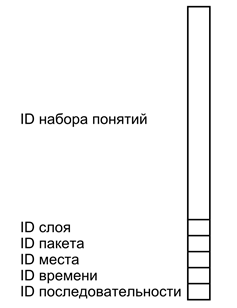
Simple description format
Let’s take the previous example and designate the waves of identifiers corresponding to the concepts used as C1 ... C7 (figure below).
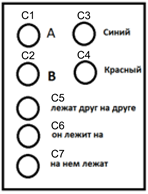
Concepts used to describe
Then the description of what “the red object A lies on the blue object B” will look like the picture below.
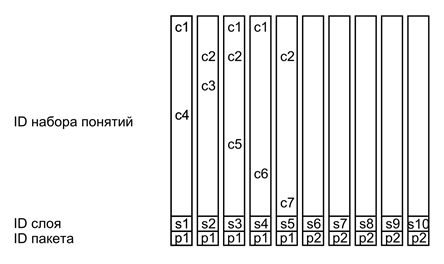
Example of a complex description
In this example, each of the layers in the package is a simple description with its own layer identifier. All package layers have a common package identifier p1. When one complex description ends, the other following it has a different identifier for the package p2 (the concepts of the second description are not shown in the figure).
For such a design to be workable, the brain needs a fairly complex system that creates identifiers that form packages. Moreover, for each of the zones of the cortex, it may be necessary to have its own set of such identifiers, which is appropriate for it.
For example, take a sequence of visual perceptions. The spasmodic micromotion of the eyes, called microaccades, cause the eye to scan a small portion of the image located in the center of the retina. All the images that are obtained in the process of such a scan can presumably be united by a common identifier. The micromotion of the eyes is controlled by the upper tubercles of the quadruple. It can be assumed that it is they who encode such an identifier. After several microsaccades, a strong jump occurs, called a saccade (the saccades are shown in the figure with the head of Nefertiti above). Each saccade causes a change in the micro saccade identifier.
It can be assumed that microaccades are fundamentally important for the primary visual cortex. A common identifier tells the cortex that a series of consecutive images describes the same object, but in different positions on the retina, which allows them to be combined into a single description and realize recognition that is invariant to the position on the retina.
A longer event is a series of saccades. Since the series refers to looking at a single picture, the resulting descriptions can also be linked together by another common identifier - saccade identifiers. But this identifier is no longer essential for the primary, but for the secondary and deeper levels of the visual cortex, where subsequent processing of information occurs. An identifier telling the cortex that everything that we see during a series of saccades is one and the same picture, allows us to correlate the same images that are visible at different places in the retina.
The saccade identifier should change when the picture being examined changes significantly. For example, with a strong turn of the head, switching attention, changing the plan or scene in the movie. Switching attention can be encoded by the elements of the limbic system of the brain and extend to many cortical zones tied to this. At the same time, the hippocampus identifiers encoding the spatio-temporal descriptions of events are present in the description system. In short, the system of identifiers that define the package can be quite complex, and determined by the features of the information that each particular zone of the crust deals with.
Using identifiers, it is easy to organize the fixing of a sequence of events. For example, if you take an identifier consisting of two fragments, then alternately changing one of them, you can get the associative connectivity of neighboring descriptions (figure below).
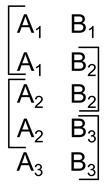
Sequence Encoding
Each such identifier will contain an element from the previous and subsequent identifier. Remembering the time sequence of images with such identifiers, for each image we can find its two neighbors in the timeline. Having complicated the identifier easily, it is possible to encode not only the general connectedness, but also the direction of the flow of time.
It should be noted that in our model, each memory has a rich system of identifiers. This allows access to the memory through many completely different associations. One can recall something based on the coincidence of the meaning of the descriptions. You can associate informational pictures by the place or time of the events described. You can reproduce a sequence of images related to a single event. It is easy to see that such access to memories has much in common with the approaches that are used to create traditional relational databases.
The literature used
Continuation
Previous parts:
Part 1. Neuron
Part 2. Factors
Part 3. Perceptron, convolutional networks
Part 4. Background activity
Part 5. Brain waves
Part 6. Projection system
Part 7. Human-computer interface
Part 8. Isolation of factors in wave networks
Part 9. Patterns of neuron detectors. Rear projection
Part 10. Spatial self-organization
Part 11. Dynamic neural networks. Associativity
Part 12. Traces of memory
Part 13. Associative memory
Part 14. Hippocampus
Part 15. Consolidation of memory
Alexei Redozubov (2014)
